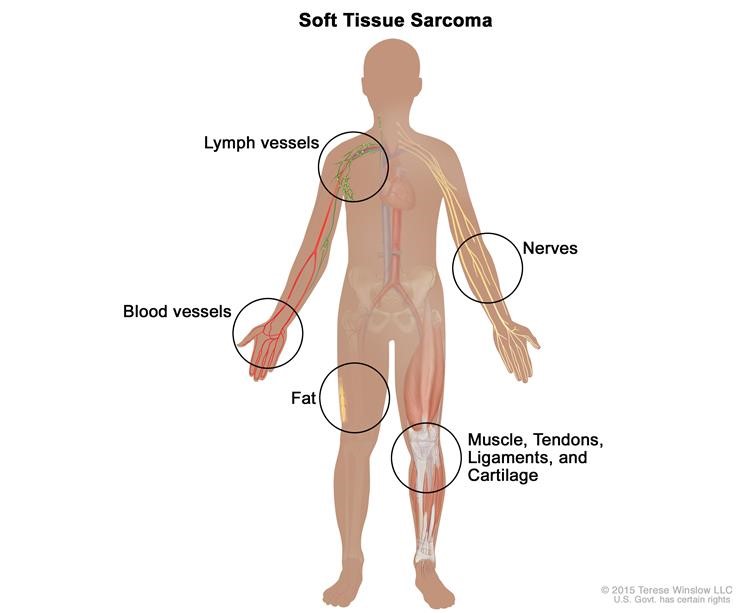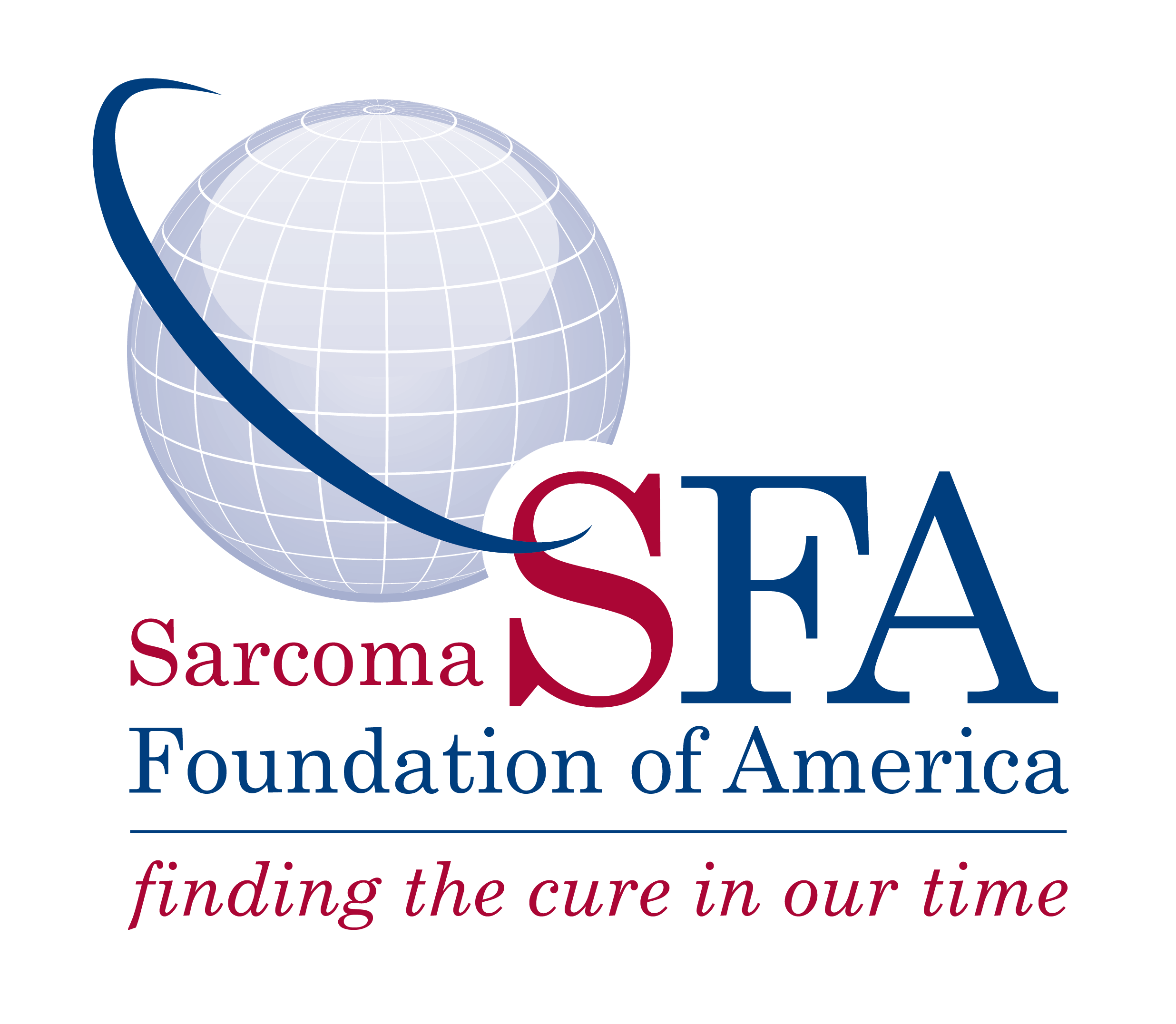What is Sarcoma?
Sarcoma is a rare type of cancer and typically produces malignant tumors derived from the connective tissue. There are more than 70 sarcoma types and subtypes.
Soft Tissue Sarcoma
Soft tissue sarcoma broadly defines cancers that develop in the body’s soft tissues (i.e. muscles, tendons, fat, lymph vessels, blood vessels, and nerves). While these cancers are most commonly found in the head, neck, arms, legs, chest, and abdomen, they can develop anywhere in the body. There are various different types of soft tissue sarcoma, and depending on the type of soft tissue the cancer started in, the cells will look different under a microscope. Soft tissue sarcoma occurs in adults and children.
There are approximately 14,000 soft tissue sarcomas and 2,000 bone sarcomas per year in the United States. These as a group account for only 1% of all cancers. For comparison, there are 130,000 breast cancers per year. Thus, this is a rare cancer type, and given the many types within sarcoma, and sub-types that can be very different from one another, it is important that a specialist be seen.

Risk factors for developing soft tissue sarcoma include these inherited disorders:
- Retinoblastoma,
- Neurofibromatosis type 1 (von Recklinghausen disease),
- Tuberous sclerosis (Bourneville disease),
- Familial adenomatous polyposis (Gardner syndrome);
- Li-Fraumeni syndrome;
- Werner syndrome (adult progeria);
- Nevoid basal cell carcinoma syndrome (Gorlin syndrome).
Other risk factors include:
- Past radiation therapy treatment for certain types of cancers,
- exposure to certain chemicals (Thorotrast aka thorium dioxide; vinyl chloride, arsenic);
- Prolonged swelling in the arms and legs also known as lymphedema;
- having AIDS (Acquired immune deficiency syndrome) and Epstein-Barr virus infection at the same time.
Signs and symptoms: A sarcoma may begin as a swollen area or lump under your skin that is painless. Sarcomas that are in the abdomen may go unnoticed and not cause any symptoms until they become very large in size. When the sarcoma grows larger in size it will begin to press on surroundings that may contain nerves, organs, and/or blood vessels and can start causing pain, weakness, and/or difficulty breathing. Please consult your doctor if you have any of these signs and symptoms.
Sources:
https://www.cancer.gov/types/soft-tissue-sarcoma/patient/adult-soft-tissue-treatment-pdq
https://www.cancer.gov/types/soft-tissue-sarcoma/patient/child-soft-tissue-treatment-pdq
Types of Soft Tissue Sarcoma
Rhabdomyosarcoma
This type of sarcoma usually begins in the muscles attached to bones and in the muscles that help the body to move. It shows skeletal muscle differentiation. Rhabdomyosarcoma is the most common type of soft tissue sarcoma in children. There are several different subtypes of RMS.
While it can begin in many areas of the body, there are 3 main types:
- Embryonal occurs in the head and neck, or the genital or urinary organs. This is the most common type of rhabomyosarcoma.
- Alveolar occurs more commonly in the arms or legs, chest, abdomen, genital organs, or anal area.
- Anaplastic is the least common type of childhood rhabomyosarcoma.
Risk factors:
- Li-Fraumeni syndrome,
- Pleuropulmonary blastoma,
- Neurofibromatosis type 1 (NF1),
- Costello syndrome,
- Beckwith-Wiedemann syndrome,
- Noonan syndrome;
- children born with high birth weights or larger than expected when born have increased risk of embryonal rhabdomyosarcoma.
- Most often, the cause of rhabdomyosarcoma is unknown.
Signs and symptoms depend on where the cancer is in the body and include:
- lump or swelling that grows in size or does not go away, and may or may not be painful;
- eye bulging;
- headache;
- difficulty urinating or having bowel movements;
- blood in urine;
- abnormal bleeding seen in the nose, throat, vagina, or rectum.
Please consult your doctor if you or your child/adolescent has any of these signs or symptoms.
https://www.cancer.gov/types/soft-tissue-sarcoma/patient/rhabdomyosarcoma-treatment-pdq
Leiomyosarcoma (LMS)
This type of sarcoma derives from the smooth muscle of the body wherever it is found, such as the walls of blood vessels, the uterine wall, and other sites. The most common site for this is the uterus, followed by soft tissue of the arms and legs. There are no specific risks factors for this.
Angioarcoma (AS)
This is a neoplasm of adults, often on the skin including the scalp in sun-exposed areas. It may also arise in internal organs such as the liver or the spleen. It is derived from the internal lining of blood vessels, the endothelium.
There are no known genetic risk factors for this, although the scalp tumors are often associated with sun-exposure .
Liposarcoma (LPS)
This is a very common type of sarcoma, and is derived from the fat cells (adipocytes) of the body and, while it can occur anywhere, it is most frequent deep in the body near the kidneys (retroperitoneum), pelvis, and groin. There are several subtypes of LPS (some listed below):
- Well differentiated LPS – this is a low grade sarcoma that grows slowly.
- Myxoid/round cell LPS – this occurs in the deep soft tissue, within the muscles of the body; pure myxoid LPS is low grade, while any round cell component is considered high grade.
- Dedifferentiated LPS – this is a tumor that no longer resembles fat cells, and is a high grade tumor. This can be found next to the well differentiated LPS.
Myxofibrosarcoma (MYFS)
This is a tumor derived from fibroblasts, the supporting cell of the body found everywhere, including tendons, deep skin, and even around muscle. It can be low grade or high grade.
Undifferentiated Pleomorphic Sarcoma (UPS)
This is also a very common type of sarcoma and is derived from primitive connective tissue. It is a high-grade sarcoma found in many places in the body.
Synovial Sarcoma (SYS)
This is a tumor that has no known definitive cell of origin. It is found near joints, often on the leg near the knee in young adults.
Some Other Soft Tissue Sarcomas
- Epithelioid Sarcoma (distal extremities in young adults mainly)
- Alveolar Soft Part Sarcoma (often young patients in deep soft tissue)
- Malignant Peripheral Nerve Sheath Tumor (MPNST, derived from the lining of nerves) Associated with Neurofibromatosis
- Malignant Solitary Fibrous Tumor (MSFT) – on extremities or chest/lung of adults
Types of Bone Sarcoma
Ewing Sarcoma (EWS)
With Ewing sarcoma, a tumor forms from a specific cell type found in the bone or soft tissue. The tumor can be found in the bones of the legs, arms, feet, hands, chest, pelvis, spine, or skull. It may also be found in the body’s soft tissues. Ewing sarcoma is most commonly found in adolescents and young adults.
Signs and symptoms include:
- lump that may feel soft and warm;
- swelling and pain near the tumor, usually in arms, legs, chest, back, or pelvis;
- fever for unknown reason;
- bone that breaks spontaneously with no injury to area.
Please consult your doctor if you or your child/adolescent has any of these signs or symptoms.
https://www.cancer.gov/types/bone/patient/ewing-treatment-pdq
Osteosarcoma (OS or OST)
These cancerous cells form in the bone, and start in cells called osteoblasts, which are a type of bone cell that eventually becomes new bone tissue. Osteosarcoma in most commonly found in adolescents and is seen in the ends of long bones in the arms and legs, especially near the knee. Osteosarcoma is the most common type of bone cancer.
Risk factors:
- Past radiation therapy treatment
- Past treatment with alkylating agents, anticancer medications
- Specific change in the RB1 gene
- Bloom syndrome
- Diamond-Blackfan anemia
- Li-Fraumeni syndrome
- Paget disease
- Hereditary retinoblastoma
- Rothmund-Thomson syndrome
- Werner syndrome
Signs and symptoms:
- bone or joint pain
- bone that breaks spontaneously with no injury to area
- swollen area over a bone or bony part of body
Please consult your doctor if you or your child/adolescent has any of these signs or symptoms.
https://www.cancer.gov/types/bone/patient/osteosarcoma-treatment-pdq
Sarcoma Diagnostic Testing & Treatment
With all of the different types of sarcomas, Diagnostic testing, such as X-rays, MRI (magnetic resonant imaging), CT scans (CAT scans), PET scans, Bone scans, is initially used to find and detect the tumor(s). If diagnostic testing detects a tumor, definitive diagnosis is done by biopsy of the tumor. The type of biopsy used will be determined by your doctor based on the size of the tumor and where the tumor is located.
Where To Go
In this rare group of cancers, it is critical that patients be seen (after an initial needle core biopsy diagnosis at a local hospital) in a large Cancer Center, nearly all of which around the country have a Sarcoma Team (Orthopedic Oncologist (surgeon), Medical Oncologist (chemotherapy), Radiology specialist in bone/soft tissue tumors, Radiation Therapist, and Pathologist who is a Sarcoma Expert.
The general sequence would be scans, followed by surgery, then an evaluation as to whether chemotherapy and or radiation therapy should be given. Sometimes, for certain tumors, either chemotherapy or radiation therapy would be given prior to surgery, to shrink the tumor.
The Sarcoma Foundation of America strives to find a cure for sarcoma through research grant funding and increased awareness of the disease. Learn how you too can help!

